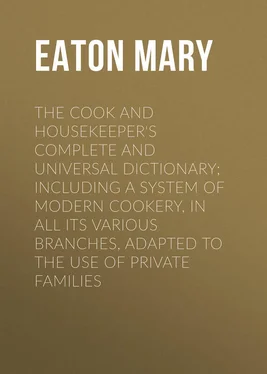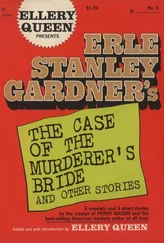Mary Eaton - The Cook and Housekeeper's Complete and Universal Dictionary; Including a System of Modern Cookery, in all Its Various Branches, Adapted to the Use of Private Families
Здесь есть возможность читать онлайн «Mary Eaton - The Cook and Housekeeper's Complete and Universal Dictionary; Including a System of Modern Cookery, in all Its Various Branches, Adapted to the Use of Private Families» — ознакомительный отрывок электронной книги совершенно бесплатно, а после прочтения отрывка купить полную версию. В некоторых случаях можно слушать аудио, скачать через торрент в формате fb2 и присутствует краткое содержание. Издательство: Иностранный паблик, Жанр: foreign_antique, foreign_prose, на английском языке. Описание произведения, (предисловие) а так же отзывы посетителей доступны на портале библиотеки ЛибКат.
- Название:The Cook and Housekeeper's Complete and Universal Dictionary; Including a System of Modern Cookery, in all Its Various Branches, Adapted to the Use of Private Families
- Автор:
- Издательство:Иностранный паблик
- Жанр:
- Год:неизвестен
- ISBN:нет данных
- Рейтинг книги:5 / 5. Голосов: 1
-
Избранное:Добавить в избранное
- Отзывы:
-
Ваша оценка:
- 100
- 1
- 2
- 3
- 4
- 5
The Cook and Housekeeper's Complete and Universal Dictionary; Including a System of Modern Cookery, in all Its Various Branches, Adapted to the Use of Private Families: краткое содержание, описание и аннотация
Предлагаем к чтению аннотацию, описание, краткое содержание или предисловие (зависит от того, что написал сам автор книги «The Cook and Housekeeper's Complete and Universal Dictionary; Including a System of Modern Cookery, in all Its Various Branches, Adapted to the Use of Private Families»). Если вы не нашли необходимую информацию о книге — напишите в комментариях, мы постараемся отыскать её.
The Cook and Housekeeper's Complete and Universal Dictionary; Including a System of Modern Cookery, in all Its Various Branches, Adapted to the Use of Private Families — читать онлайн ознакомительный отрывок
Ниже представлен текст книги, разбитый по страницам. Система сохранения места последней прочитанной страницы, позволяет с удобством читать онлайн бесплатно книгу «The Cook and Housekeeper's Complete and Universal Dictionary; Including a System of Modern Cookery, in all Its Various Branches, Adapted to the Use of Private Families», без необходимости каждый раз заново искать на чём Вы остановились. Поставьте закладку, и сможете в любой момент перейти на страницу, на которой закончили чтение.
Интервал:
Закладка:
BREWING UTENSILS. The most desirable object in the process of brewing is the fixing of the copper, so as to make the fire come directly under the bottom of it. Many coppers are injured, and rendered unserviceable, for want of proper attention to this particular. The method adopted by the most experienced bricklayers is to divide the heat of the fire by a stop; and if the door and the draft be in a direct line, the stop must be erected from the middle of each outline of the grating, and parallel with the centre sides of the copper. The stop is nothing more than a thin wall in the centre of the right and left sides of the copper, ascending half way to the top of it; on the top of which must be left a small cavity, four or five inches square, for a draft of that half part of the fire which is next to the copper door, to pass through, and then the building must close all round to the finishing at the top. By this method of fixing the copper, the heat will communicate from the outward part of the fire round the outward half of the copper through the cavity; as also will the furthest part of the fire, which contracts a conjunction of the whole, and causes the flame to slide gently and equally all round the bottom of the copper. Considerable advantages result from this position of the copper. If the draught under it were suffered at once to ascend, without being thus divided, the hops would be scorched in the boiling, and liable to stick to the sides, which would considerably injure the flavour of the liquor, unless kept continually stirring. It will also save the consumption of fuel, and preserve the copper much longer than any other method, as there will be no difficulty in boiling half a copper full at a time without doing it any injury. – The next article of consideration in this case is the Mash-tub. This should be proportioned to the size of the copper, and the quantity of beer intended to be brewed. The grains should not be kept in the tub any longer than the day after brewing, as in hot weather especially the grains begin to turn sour as soon as they are cold; and if there be any sour scent in the brewhouse at the time the liquor is tunned, it will be apt to injure the flavour of the beer. – Tubs and Coolers require to be kept perfectly sweet and clean, and should not be used for any other purpose. In small houses, where many vessels are cumbersome and inconvenient, it is too common to use the same tubs for both washing and brewing; but this ought not to be done where it can be avoided; and where it is unavoidable, the utmost care is necessary to give them a double washing, scouring, and scalding. Coolers also require considerable care, or by the slightest taint they will soon contract a disagreeable flavour. This often proceeds from wet having infused itself into the wood, it being apt to lodge in the crevices of old vessels, and even infect them to such a degree, that it cannot be removed, even after several washings and scaldings. One cause incidental to this evil is, using the brewhouse for the purposes of washing, which ought never to be permitted, where any other convenience can be had; for nothing can be more injurious than the remains of dirty suds, left in vessels intended for brewing only. Nor should water be suffered to stand too long in the coolers, as it will soak into them, and soon turn putrid, when the stench will enter the wood, and render them almost incurable. More beer is spoiled for want of attention to these niceties than can well be imagined, and the real cause is seldom known or suspected; but in some families, after all the care that is taken in the manufacture of the article, the beer is never palatable or wholesome. – Barrels should be well cleaned with boiling water; and if the bung-hole will admit, they should be scrubbed inside with a hard brush. If they have acquired a musty scent, take out the heads, and let them be well scrubbed with sand and fuller's earth. Then put in the head again, and scald it well; throw in a piece of unslaked lime, and close up the bung. When the cask has stood some time, rinse it well with cold water, and it will then be fit for use. New casks likewise require attention, for they are apt to give the liquor a bad taste, if they be not well scalded and seasoned several days successively before they are used; and old casks are apt to grow musty, if they stand any time out of use. To prevent this, a cork should be put into every one of them as soon as the cock or fosset is taken out; the vent and the bung-hole must also be well closed. The best way to season new casks is to boil two pecks of bran or malt dust in a copper of water, and pour it in hot; then stop it up close, and let it stand two days. When the cask is washed and dried, it will be fit for use.
BREWING MACHINE. Where a family usually consume ten gallons of beer, or upwards, in a week, there is a Brewing Machine lately invented, which will be found singularly convenient and advantageous, and comparatively of little expense. The use of it in brewing curtails the labour, shortens the time in which the operation may be performed, greatly diminishes the quantity of fuel, and may be placed within very narrow limits, in the house of any tradesman in the most crowded city. Eighteen gallons of good beer may be brewed with this machine in the course of six hours, or a larger quantity with a machine of proportionate dimensions, in the same space of time. The process is so simple, that it may be comprehended by any person of ordinary capacity, and once seeing the operation performed will be sufficient. In the common mode of brewing, the principal difficulty consists in ascertaining the degrees of heat necessary to the production of good beer, without the use of a thermometer; but in the use of this machine, this difficulty is completely obviated. – The machine complete is represented by figure A; and B, C, D, E, F, represent its several parts. B is the bottom, made of strong sheet-iron, standing upon three legs. The hollow part of it contains the fire, put in at a door, the latch of which appears in front. The tube which projects upwards, is a stove pipe to carry off the smoke; and the circular pan that is seen between the legs, is a receptacle for the ashes or cinders that fall down through the grate above. C is a sheet-iron vessel, tinned on the inside, the bottom of which fits into the top of B; and the cock in C is to let off the wort, as will be seen hereafter. D is the lid of this vessel. E is made of sheet-iron, tinned inside and out, and full of holes to act as a strainer. It is to hold the malt first, and the hops afterwards; it goes into C, as may be seen in figure A. In the middle of E is a round space, F, made of the same metal, and rising up from the bottom, having itself no bottom. It has holes in it all the way up, like the outer surface of E. – In preparing for brewing, the machine is put together as in A, except placing on the lid. The first thing is to put the malt, coarsely ground, into E, and no part into F, or into the circular space between C and E; otherwise E cannot act as a strainer, when the liquor is drawn off; and in this consists its principal use. Having put in the malt, then add the water which of course flows into any part of the vessel C. Stir the malt well with a stick, or with something that will separate it completely, so that no adhesion may be formed by the flour of the malt. This is very apt to be the case in the common mode of brewing, when water is poured hot upon the malt; but here the water is applied in a cold state, so that there is little trouble in separating the malt completely in the water. If the small machine be used, which is adapted to a bushel of malt, and the beer is to be fully equal in strength to London porter, then eighteen gallons to the bushel may be considered as the general estimate; and for this purpose the first mash is to receive twelve gallons of cold soft water, which will produce nine gallons of wort. Having stirred the malt very carefully, light the fire under it, and get the liquor quickly to 170 or 180 degrees of heat. This may be ascertained by lifting off the lid, and dipping the thermometer from time to time into the centre F, and keeping it there a minute to give the quicksilver time to rise. While the mash is coming to this heat, stir the malt well three or four times. When the liquor has acquired its proper heat, put out the fire, and cover the whole of the machine with sacks, or something that will exclude the external air. In this state the mash remains for two hours: the cock is then turned, and nine gallons of wort will be drained off. Put the wort into a tub of some sort, and keep it warm. Then put into the machine twelve gallons more of water, rekindle the fire, and bring the heat to 170 degrees as soon as possible; when this is done, extinguish the fire, and let the mash now stand an hour. Draw off the second wort; and if only one sort of beer is wanted, add it to the first quantity. Now take out the grains, lift out E, clean it well, and also the inside of C. Replace E, put the hops into it, and the whole of the wort into the machine. Cover it with the lid, light the fire a third time, and bring the liquor to a boil as soon as possible. Let it boil a full hour with the lid off, and boil briskly all the time. The use of the centre F will now appear; for the machine being nearly full to the brim, the bubbling takes place in the centre F only, where there are no hops. There is a great boiling over in this centre, but the liquor sent up falls into E, and so there is no boiling over of C. When the full hour of brisk boiling has expired, put out the fire, draw off the liquor, leaving the hops of course in E. The liquor is now to go into shallow coolers; and when the heat is reduced to 70 degrees, take out about a gallon of the liquor, and mix it with half a pint of good yeast. Distribute it equally among the different parcels of wort, afterwards mix the whole together, and leave the liquor till it comes down to about sixty degrees of heat. The next removal is into the tun-tub, in which capacity C, without the addition of E, will serve very well. While the liquor is cooling, remove the spent hops from E, the stove pipe from B, the ash-receiver from the bottom. The machine remaining now as a tun-tub, draw off the liquor as soon as it is down to 60 degrees; or take it out of the coolers, pour it into the tun-tub, and put on the lid. If the weather be very cold, or the tun-tub be in a cold place, cover it with something to keep it warm. Here the fermentation takes place, sometimes sooner and sometimes later; but it generally shows itself by a head beginning to rise in about eight or ten hours; and at the end of eight and forty hours the head assumes a brownish appearance, and is covered with yeast instead of froth. The beer is then to be tunned into well-seasoned casks, sweet and sound, or all the expense and labour will be lost. The cask being fixed on the stand in the cellar, and the beer ready, skim off the yeast, and keep it in a deep earthen vessel. Draw off the beer into a pail, and with the help of a wooden funnel fill the cask quite full. The beer will now begin to ferment again, and must be allowed to discharge itself from the bung-hole. When the working has ceased, the cask is again filled up with the surplus beer; and a handful of fresh hops being added, the bung is finally closed down. If the whole process has been properly attended to, such a cask of beer will be clear in a week; and as soon as clear it may be tapped. Small beer may be tapped in less time. On a larger scale, or with casks of a smaller size, two sorts may be made, ale and small beer, taking the first wort for the former, and the second for the latter. – The advantages attending the Patent Machine are very obvious; for though the process appears to be minute, it is easily conducted, and but little time is required for the purpose. In the common method of brewing, the water must be carried from the copper to the mash-tub, while the machine serves for both purposes at once. With the common utensils the process is necessarily much slower, and the fuel consumed is nearly ten times as much; but the great convenience of all is the little room required and the place of brewing. In the common way there is wanted a copper fixed in brick-work, and for a family of any considerable size a brewhouse is indispensable. On the contrary, the machine is set up opposite any fire place, and the pipe enters the chimney, or is put into the fire place. There is no boiling over, no slopping about; and the operation may be performed upon a boarded floor, as well as upon a brick or stone floor. If there be no fire place in the room, the pipe can be projected through an opening in the window, or through the outside of any sort of building, not liable to suffer from the heat of the pipe. Even a garden walk, a court, or open field will answer the purpose, provided there be no rain, and the mash-tub be kept sufficiently warm. When the brewing is finished, the machine should be well scalded, rubbed dry, and kept in a dry place. The two coolers, G G, placed on different casks, have no necessary connection with the machine. They are made of wood or cast-iron, of a size to fit one within another to save room. The Patent Machine is sold by Messrs. Needham and Co. 202, Piccadilly, London. The price of one for brewing a bushel of malt is £8, for two bushels £13, for three £18, for four £24, for five £30, and for six £33. If the article be thought expensive, a few neighbouring families might unite in the purchase, and the money would very soon be more than saved in the economy of brewing.
Читать дальшеИнтервал:
Закладка:
Похожие книги на «The Cook and Housekeeper's Complete and Universal Dictionary; Including a System of Modern Cookery, in all Its Various Branches, Adapted to the Use of Private Families»
Представляем Вашему вниманию похожие книги на «The Cook and Housekeeper's Complete and Universal Dictionary; Including a System of Modern Cookery, in all Its Various Branches, Adapted to the Use of Private Families» списком для выбора. Мы отобрали схожую по названию и смыслу литературу в надежде предоставить читателям больше вариантов отыскать новые, интересные, ещё непрочитанные произведения.
Обсуждение, отзывы о книге «The Cook and Housekeeper's Complete and Universal Dictionary; Including a System of Modern Cookery, in all Its Various Branches, Adapted to the Use of Private Families» и просто собственные мнения читателей. Оставьте ваши комментарии, напишите, что Вы думаете о произведении, его смысле или главных героях. Укажите что конкретно понравилось, а что нет, и почему Вы так считаете.












![John Bruce - The Lettsomian Lectures on Diseases and Disorders of the Heart and Arteries in Middle and Advanced Life [1900-1901]](/books/749387/john-bruce-the-lettsomian-lectures-on-diseases-and-disorders-of-the-heart-and-arteries-in-middle-and-advanced-life-1900-1901-thumb.webp)